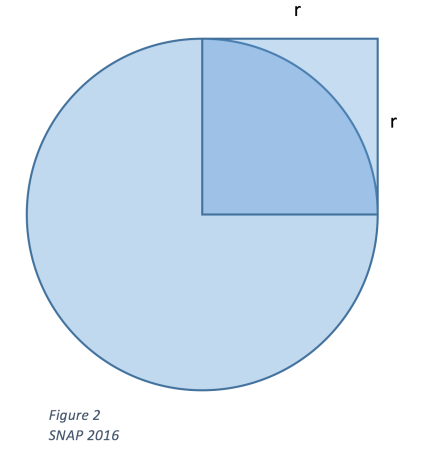The power to create curiosity in ourselves by using the ANIE/SNAP framework to guide teaching practice once again proves so important. If we want to teach students to have a deeper understanding of math, then we (teachers) need to have a deep understanding first. After all, if we do not have the concept down, how can we expect our students to learn from us?
The example that I am sharing today highlights the learning conversation that I had with one of our middle school math teachers from Rosedale Traditional – Dan Mazerolle. A conversation where he taught me how to find the area of a circle in a fashion that made a whole lot more sense to me. I now have a new appreciation and understanding of the “why” when it comes to the concept of “pi” or 3.14 (truncated).
Dan explained that sometimes we overcomplicate the whole idea of “pi” in our math system. In order to explain a simpler (and practical) concept, he wrote down the formula to find the area of a circle:
A = πr2
Or
Area = 3.14 x radius of circle, squared
He asked, “how would we draw r2?”
We agreed on this:

We were able to draw the square – see above. However, how does this fit into a circle…what if it were drawn like this (see figure 2)?

The reason we use “Pi” is because Pi represents the value of the area of a circle when compared to the corresponding square of equal depth and width – 3.14 squares in fact. It would take more than three squares, but less than 4 squares to fill the area of the corresponding circle. See figure 3 below:

This premise allows for a more intuitive way to calculate (and more importantly estimate) the area of a circle.
What if the diameter of a circle is 10 units (radius would be 5 units). What would the area of the large square below be?
10 x 10 = 100 units2
How about the area of the circle?
3.14 x 52 = 78.5 units2
Following this logic means that a circle represents 78.5% of the area of a corresponding square (rounded to the nearest hundredth). I think that this is pretty cool!

What does this mean for budding mathematicians? The next time the area of a circle needs to be calculated or estimated, there is another way – a way that resonates with me in a “good sense” kind of way!
Note: 78.55% is even more exact (rounded to the nearest thousandth).

I’ve used a similar approach…
If r=1m then the area of each square is 1m2.
There are 4 of them to make up the 4 quadrants of the circle A=4m2.
But because of the curved line the circle doesn’t completely fill the square so the area of the circle is a bit less, actually it’s 3 and a bit, or 3.14 m2!
LikeLiked by 1 person
Yes! Exactly. Thank you for sharing your approach.
LikeLiked by 1 person
I know it’s been almost 3 years since you’ve made this comment, but I love this equation.
I’m trying to buy a (round) water tank to put into a small (square) area to the side of my house and this mathematical solution is really helpful, and really cool in a maths nerd sought of way!!
LikeLike
hi
to get 78.5 series. you either multiply pi on 25 (78.5) or divide on 4 (0.785) see also 4*25 = 100
a square inside a circle is 63.66 % fastest. is to 200/pi =63.66 but pi/ (pi*pi/2 (1.57)=4.93)=0.6366
and pi*20.26 =63.66 ( see 4.93*20.26=100)
in a cube, the circle is 52.35%
either pi/6 =0.5235 or pi*16.66666=52.35 (6*16.666=100)
i have started to look for formulas for polygons. but that is then square root contry. and pi cant be squared. its a trancedental number(they say)
LikeLiked by 1 person
Interesting! I had not considered finding the area of a square within a circle or a sphere inside a cube. Thank you for sharing this approach!
LikeLiked by 1 person
Hey there, thanks for your input.
LikeLike
I believe the percentage rounded to the nearest thousandth would be 78.54%, not 78.55%. The closest I can get on my smart phone calculator is is .7853981634.
LikeLike
Also, I think that if you have four circles of the same size inside that square they’ll still have the same area as one circle.
LikeLike
I agree.
LikeLike
Actually. The 78.5% is pi/4 which is 78.53981634%
LikeLike